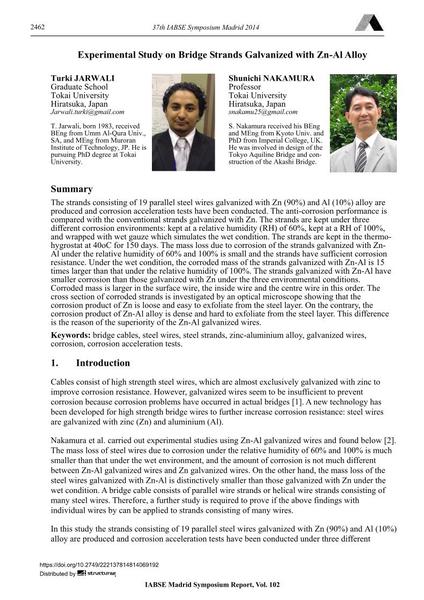Experimental Study on Bridge Strands Galvanized with Zn-Al Alloy

|
|
|||||||||||
Bibliografische Angaben
| Autor(en): |
Turki Jarwali
Shunichi Nakamura |
||||
|---|---|---|---|---|---|
| Medium: | Tagungsbeitrag | ||||
| Sprache(n): | Englisch | ||||
| Tagung: | IABSE Symposium: Engineering for Progress, Nature and People, Madrid, Spain, 3-5 September 2014 | ||||
| Veröffentlicht in: | IABSE Symposium Madrid 2014 | ||||
|
|||||
| Seite(n): | 2462-2469 | ||||
| Anzahl der Seiten (im PDF): | 8 | ||||
| Jahr: | 2014 | ||||
| DOI: | 10.2749/222137814814069192 | ||||
| Abstrakt: |
The strands consisting of 19 parallel steel wires galvanized with Zn (90%) and Al (10%) alloy are produced and corrosion acceleration tests have been conducted. The anti-corrosion performance is compared with the conventional strands galvanized with Zn. The strands are kept under three different corrosion environments: kept at a relative humidity (RH) of 60%, kept at a RH of 100%, and wrapped with wet gauze which simulates the wet condition. The strands are kept in the thermo- hygrostat at 40oC for 150 days. The mass loss due to corrosion of the strands galvanized with Zn- Al under the relative humidity of 60% and 100% is small and the strands have sufficient corrosion resistance. Under the wet condition, the corroded mass of the strands galvanized with Zn-Al is 15 times larger than that under the relative humidity of 100%. The strands galvanized with Zn-Al have smaller corrosion than those galvanized with Zn under the three environmental conditions. Corroded mass is larger in the surface wire, the inside wire and the centre wire in this order. The cross section of corroded strands is investigated by an optical microscope showing that the corrosion product of Zn is loose and easy to exfoliate from the steel layer. On the contrary, the corrosion product of Zn-Al alloy is dense and hard to exfoliate from the steel layer. This difference is the reason of the superiority of the Zn-Al galvanized wires. |
||||
| Stichwörter: |
Korrosion Stahllitzen
|
||||
